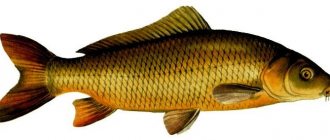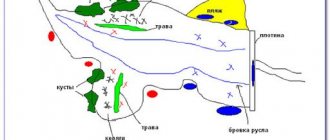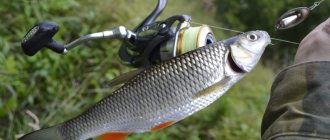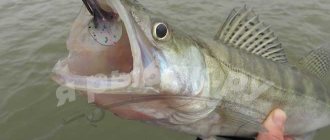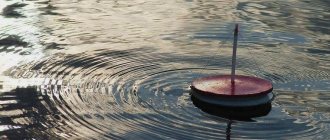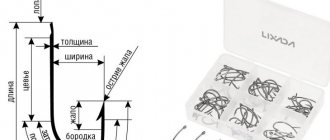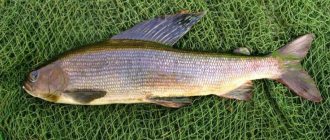Information
Characteristics
Carp is one of the largest freshwater fish. Among fishing enthusiasts there are stories and legends about the power and cunning of this representative of the ichthyofauna. Having measured your strength with a wild carp once, you want to repeat these minutes of fierce struggle again and again. Some hobbyists stop fishing for other types of fish and focus their efforts on catching carp. Wild carp, like its cultivated relative, are among the heat-loving species. Both spawning and feeding of fish occur in the summer. But even in the fall, the carp continues to feed in order to stock up on the necessary nutrients for the whole winter. In October you can still purposefully hunt for the freshwater giant, and already in November bites are extremely rare. To successfully catch carp in October, there are a number of nuances that a fisherman should know. There are specific features in the equipment of the fishing rod, in the preparation of bait, in determining the location and in the selection of catchable baits.
Groundbait and bait
The choice of bait mixture, as well as catchable bait, depends on several factors. First of all, it is necessary to take into account the characteristics of local fish. On some reservoirs, carp feed on corn, peas and potatoes even in October. The fish were accustomed to this food by local anglers, so wild carp may not react to store-bought mixtures. In the southern regions, sunflower cake or shell meat is used as bait and bait. In this regard, carp can even completely ignore boilies. Some fishermen prepare fashionable boilies themselves. It’s enough just to make balls for bait and bait according to the following recipe.
- Semolina (corn) grits are combined in equal proportions with bird food after preliminary grinding in a coffee grinder. This mixture should make up from a third to a half of the total weight of the bait.
- 45% soy flour, 5% fish and bone meal, 5 teaspoons of garlic, cumin, cinnamon, 10 ml of sunflower oil and 10 chicken eggs are added to the dry composition.
- After obtaining a homogeneous dough, you can add any food coloring to it. Next, balls of different sizes are made.
- Future boilies are lowered into boiling water, and after surfacing they are removed and dried for several days.
In addition to boilies, in October you can catch carp using a bunch of worms, shell meat, cake, steamed peas and pearl barley, canned corn, and boiled potatoes.
This is interesting: Catching carp in May: what and how to catch carp in May
Lure
Fishing for carp is always more successful when the angler uses bait to feed the fishing spot with loose compounds, from which lighter particles are constantly released and floated to the surface. Bait for catching carp is prepared on a base of breadcrumbs with the addition of pearl barley, fish feed and a strong attractant concentrated on the smell of a sweet component, mead, chicory, vanilla or cinnamon. The bait is prepared without the addition of soil or sand, using purely edible ingredients. The cooked porridge is not strained, allowing it to become gluten, which, as the lump of bait dissolves in the water, will release particles of crackers and feed flour to the surface of the reservoir. The column of floating particles and the smell of food will lure the fish from afar, both visually and based on its developed sense of smell.
Important! An effective bait method is filling a mesh bag with bait and then installing it on the bottom of the reservoir at the fishing site.
This type of feeding does not frighten the flock gathered at the point by throwing the next portions of bait and allows you to catch fish without pauses for the next approach of the fish to the feeding table. It is worth noting that a daily fishing session requires quite a lot of complementary food and the angler must be prepared to consume 30–50 kg of the mixture, and this is especially true when fishing for carp in the current.
Peculiarities of behavior of carp and carp in October
A significant decrease in water temperature in October compared to the summer months leads to a change in the food supply of carp and carp . When the water temperature is below 10 degrees, the planktonic mass loses activity and sinks to the bottom.
Aquatic vegetation also stops growing and dies, and insect larvae begin to hibernate. This leads to increased competition when searching for food within the carp population. bites during this period are sharp and aggressive .
Lower temperatures also affect the carp and carp themselves - giving preference to warm water, the fish will drift across the reservoir in search of comfortable places for it.
These may be deep areas where the water temperature remains relatively stable in cold weather, while in shallow water it will cool much faster, but in shallow water the water will warm up faster during the thaw, forcing the carp to migrate throughout the entire water area of the reservoir.
Also, carp and even more oxygen-demanding carp will avoid places in the reservoir where the concentration of oxygen in the water will be low - this is especially true in shallow water overgrown with abundant vegetation in stagnant reservoirs , where dead algae in the process of rotting will saturate the water with carbon dioxide.
The oxygen regime is more stable at depth , which will attract carp and carp there. In reservoirs with a current, this nuance can be ignored altogether, without paying attention to it when searching for fish sites.
Attention. When fishing for carp in October in a familiar body of water with no current, pay attention to places that were overgrown with algae in the summer. Even if they are currently without vegetation, the carp will avoid them.
What to catch carp with
When choosing bait, it is very important to take into account the fishing season. The fact is that the diet of carp differs very much depending on the water temperature. So, while the water is still cool - April, May, this fish feeds on animal food, searches for various worms, larvae and mollusks in the silt and thickets of vegetation. During this period, the most effective baits will be:
- crawl out;
- a bunch of dung worms;
- leech;
- pearl barley;
- boilies with the aroma of animal bait.
With the arrival of summer and significant warming of the water, the tastes of carp change and now it is more interested in plant food. He happily eats various aquatic plants, such as water lilies, pondweed, reeds, sedge, etc. And now the most effective way to catch it is:
- boiled potatoes;
- corn;
- peas;
- boilies with sweet flavors;
Carp can maintain a summer diet in the fall, provided that there is no noticeable drop in temperature. As soon as the autumn cooling begins, the fish again begin to respond better to the animal baits that worked in the spring. You can also add crayfish meat to them.
But this does not mean that carp will not be caught in the fall using peas or potatoes. It’s just that in the fall, it’s animal bait that most often brings success. It’s the same in the summer - you can also fish with a crawler, but usually more successful fishing comes out when using plant baits.
Among the most catchy and accessible are peas, corn and potatoes, crawling and a bunch of dung worms. Boilies are also very good, although they are expensive. These are baits that allow you to maximally cut off the bites of small fish and concentrate more on catching carp. Easy to catch and prepare, they can provide effective fishing at any time of the year.
How to choose equipment
When purchasing equipment for catching carp, you need to take into account weather conditions, the speed of the river flow and the nature of the topography of the reservoir.
Rod
To make fishing for carp in early autumn successful, you need to choose the right equipment. When fishing from a boat, a short rod up to 2 m in length is suitable. The gear must be reliable to withstand the jerks of strong fish. For float rods, it is recommended to choose models that have a length of up to 6 m.
Important! If the user uses a heavy feeder feeder, then the strength characteristics must be taken into account. In this case, the test indicators must be at least 120 g.
fishing line
Carp notices thick fishing line even in muddy water. To make a leash, use braiding that has a diameter of 0.25 mm. In this case, the thickness of the main line should not exceed 0.5 mm.
Coil
To fish for strong fish, it is necessary to use inertia-free models, which have sizes from 4,000 to 6,000. The spool must hold at least 150 m of fishing line. This length should be enough to make long casts.
Important! Experienced fishermen advise using reels equipped with a friction brake.
The mechanism will help prevent damage to the equipment during sudden jerks of production.
Hook
The strength of products depends on the quality of the steel that was used in their manufacture. Overheated metal becomes too brittle and cannot withstand the jerks of a strong fish.
To check the sharpening, just run the sting along the nail plate. In case of slipping, it is necessary to sharpen the hook.
Bottom fishing rod
You can catch carp in the fall using a bottom fishing rod. The fisherman has the opportunity to cast the equipment over a distance of 150 m. The optimal length of the rod should be in the range from 3.6 to 4.5 m.
To catch large fish, a spinning-type reel is suitable, which has a size from 3,000 to 7,000. Carp is a very wary fish that can notice a fishing line that is too thick.
In cold water, individuals lose their previous activity and prefer to stay at depth. For catching carp, it is recommended to use a monofilament with a diameter of 0.3 to 0.35 mm. To reduce the risk of damage to the gear, buy braid that is more durable.
Float rod
The fall of a heavy feeder can scare away cautious fish. You can achieve a minimum noise level using a float rod. This equipment allows you to increase the number of carp bites. When fishing for carp, it is recommended to use tackle equipped with a powerful rod. Large specimens can not only tear the fishing line, but also damage the tackle.
Hair rig
When choosing equipment, keep in mind that carp do not swallow bait. The fish suck in bloodworms or worms, which are used as bait. The fish feels the metal on which the bait was attached.
The peculiarity of the hair rig is that the bait is not placed on a hook. The fish can get to the tasty morsel only after sucking the bait. The hair used is monofilament or braid, which has a diameter of up to 0.5 mm.
Feeder tackle
Fishermen are attracted by the following advantages of a feeder rod:
- Even a beginner can easily master the equipment. Fishermen value the feeder for its simplicity and versatility.
- Professionals note the high sensitivity of the equipment.
- The user gets the opportunity to cast heavy feeders long-distance.
As a fishing rod, you must choose models that have a length of 3.6 to 3.9 m. The leash must be made of fishing line, which has a thickness of 0.28 mm. To catch carp, it is recommended to choose feeders that weigh from 35 to 65 g.
A feeder rod can be used not only in autumn. In areas with dense vegetation, debris begins to wrap around the wicker. It is best to opt for monofilament line, which has a smooth surface.
In deep autumn carp can be caught over long distances. In this case, a feeder is installed into which plant or animal components can be placed.
Where to look for autumn carp
With the arrival of autumn, the carp tries to stay in the riverbed, as close as possible to the wintering pits. It rolls into the pits on the eve of freeze-up, but until then it still feeds. In autumn, carp can also be found under bushes and trees, near a steep bank. Large carp often stay in snags where there is a clay bottom.
Wild carp is a very shy fish, so fishing for carp in the fall from a boat is quite a difficult task. This fish can even be frightened by the shadow of a boat and quickly move away from the “dangerous” place. The best place for catching carp is steep bergs. There the fish practically cannot observe the angler.
Experienced fishermen are able to visually identify promising places where carp can stay. Early in the morning the carp loves to frolic and often jumps out of the water. Carp often visits shallow water areas in summer. But in the fall, he prefers to move through deep water along the edges.
Bait for carp - decoy
3
It is worth mentioning separately such a universal bait as decoy. Catching carp in autumn in many regions on reservoirs is simply unthinkable without it. For this species, they use non-traditionally prepared mash; it is good for crucian carp. For carp, semolina is hard-boiled. The recipe for its preparation is very simple. Water is poured into a small metal container. Add just a little sugar to sweeten it. Throw in a small pinch of cinnamon and wait until the water boils. Then add semolina. Its volume should be equal to the amount of water. Constantly stir and, adding a teaspoon of vegetable (preferably sunflower) oil, knead the resulting mass. That's it, the bait is ready! It holds perfectly on hooks. And it doesn’t fly off even in the current. There is a slightly modified recipe. Add semolina to very liquid pea porridge. This mass also contributes to a large number of bites.
Important Bait Ingredients in Different Fishing Conditions
Carp is still quite active in October. On sunny days it can be found in the bottom layer of water throughout the entire water area. Drizzling rain is not a problem. Fishing for carp in October becomes easier on small lakes and quarries where work has stopped. On large and medium rivers it is more difficult to catch carp.
During October, you can “train” the carp to visit the selected area using bait. Steamed cereals and crushed cake are used, which are placed in a piece of nylon stocking or a piece of gauze. New portions are added within a few days.
All bottom gear is suitable for catching carp in October. The hook is baited with bait of animal origin: worms, maggots and other available larvae. You shouldn’t completely abandon plant baits. In October, carp are often tempted by carp boilies, as well as peas and corn prepared for fishing.
Already after the first night frosts, the carp moves to wintering pits in November. Its bite becomes unstable, and the lack of bite can last throughout the entire day of fishing. In cold water, fish do not move far from the bottom recesses, even on rare sunny days. Catching carp in November involves searching for its stopping places.
The bait is thrown onto the entrances (exits) of the detected pits. If there is no bite for more than one hour, you should re-throw the tackle to another promising place. To quickly change your fishing location in the short November days, you need to select mobile gear. A feeder is excellent, and for fishing in coastal cliffs - a float rod.
The following gear is used for catching carp:
- Feeder;
- Float rod;
- "Rubber";
- Donka or zakidushka.
The optimal way to fish for carp in the fall is to fish with a feeder. This modern variety of bottom fishing rod provides interesting and productive fishing throughout the open water season, and autumn is no exception.
On the contrary, a feeder fishing rod with finely tuned equipment will allow you to notice the bite in time and make a hook, and this is very important in autumn fishing. At the same time, the feeder is much more accessible and versatile than a carp fishing rod.
Let's consider a feeder tackle option that will allow you to confidently pull out carp weighing up to 1.5 kg, and, if necessary, cope with fish weighing 3 or even more kilograms.
Since carp practically do not feed in cold water, a good autumn bait should awaken the potential trophy’s appetite, but not satiate it. This should cause the fish to take the bait on the hook.
As noted above, little bait is required - 2 kg is enough for one fishing trip. At the same time, it must be of the highest quality.
For fishing for carp in the fall, you can prepare bait with your own hands according to the following recipe:
- 1 kg of special feeder bait, for example, Sensas Super Feeder Big Fish;
- 0.5 kg fish and soy pellets;
- 200 g maggot;
- 1 can of canned corn.
The ingredients must be mixed and flavorings added. It's worth paying special attention to "spices" (garlic, pepper flavorings and the like), which usually work well in the fall on any white fish. Carp in cold water are perfectly attracted to anise and pineapple.
It is also worth considering that the use of bait brings good results in autumn carp fishing.
Now, as for the gear. Here you will need a powerful float rod; in extreme cases, you can get by with a bottom and a feeder. One way or another, you will still have to fish as close as possible to the snagged area - after all, there the fish will behave much more boldly than in the open space.
A float rod for carp is quite a powerful tackle, especially when it comes to catching trophy specimens. Wild carp is an extremely strong fish. The jerking force of a carp, as is known, can be 4-5 times greater than its own weight.
- The rod is strong and reliable, with a rigid tip, up to 5-6 meters long. Must be equipped with access rings. Fly rods and plug rods are of little use for catching large carp.
- The spinning reel must accommodate at least 100 meters of fishing line with a cross section of 0.28 - 0.30 mm. Considering the ability of the carp to cut the fishing line with its upper fin (this is not fiction, but a real fact), you should use braided line whenever possible. Of course, in the fall this is associated with a number of inconveniences (freezing of the cord at low temperatures, clogging of the guide rings with fallen leaves and other debris), but the braid makes the tackle thinner and more reliable. Fluorocarbon can also serve as an alternative to monofilament.
- The float is sliding, white, clearly visible in the dark autumn water.
- Hooks are used No. 3-6 (depending on the size of the intended trophies), round in shape, with a short shank and an impeccably sharp sting.
- The leash should be slightly thinner than the main line. The float is loaded in the usual way.
- The best sinker is a sliding one.
The autumn feeder for carp, in general terms, differs little from the summer one, however, there are some nuances here too.
- The rod is a carp or feeder rod, 3.5-4.2 m long with a test weight of 40 to 100 grams (depending on fishing conditions).
- The reel is with rear drag, the usual spool size is 3000.
- The fishing line is 0.28 -0.30 mm, thicker is possible, especially when the water becomes cloudy due to the autumn rise of water.
- Leash – 0.18 -0.2 mm, length from 20 to 50 cm.
- Hook – No. 6-8.
- The weight of the feeder is again determined by the specific fishing conditions and can reach 70-90 grams. In this case, in order to avoid “shooting the feeder”, it is necessary to use a shock leader made of thicker fishing line (usually its length is equal to the length of the rod multiplied by 2).
Successful carp fishing will only happen if the fisherman takes into account the specific conditions, based on which he will select the best bait. He will have to choose from the existing options the required color and composition.
There are imported baits designed for fishing in cold water. Such food mixtures are not suitable for ice fishing, as they contain a large amount of flavorings. Today, domestic manufacturers create good formulations in which the volume of such ingredients is reduced. If bait for carp will be carried out in winter, then it is necessary to add live components to it. These can be maggots, chopped worms and bloodworms.
We invite you to familiarize yourself with Chrysanthemum golden autumn planting and care
Many rivers where carp fishing is carried out have fairly large currents. Therefore, the feed mixture must be heavy.
- peas; - boiled potatoes; - barley grains; - corn; - millet porridge, etc.
Closer to autumn, it is necessary to add chopped worms to the composition of such bait. If carp fishing is carried out in stagnant water, then the feed mixture should be made lighter. Basically, it should consist of easily mobile substances.
- various flours, for example, wheat or corn; - sunflower seeds, which are pre-roasted and ground; - cake;
— Flavored composition, for the preparation of which you will need 5 parts of corn kernels. They are filled with salted boiled water. Then take 2 parts of beets and 3 parts of rice. These ingredients are boiled in water. After this, the beets are grated. Next, the prepared cooled ingredients are mixed in one large bowl.
At the next stage, the second mixture is prepared. To do this, crushed bran and hemp seeds are fried in a frying pan. After they cool, they are mixed with the first mixture. To improve the smell of the bait, you need to add two drops of anise oil and a little linden decoction.
- Nutritional composition prepared by mixing crayfish meat, uncooked potatoes, old cheese, garlic, bloodworms, steamed turnips with salt and crushed flax seeds; - Protein composition, which is created from 1/3 cottage cheese and animal feed, 1/4 pearl barley porridge, two parts of mashed green peas and roasted hemp seeds. You also need to add a small amount of mint oil to the mixed mixture.
— A nutritious protein composition, for the preparation of which you need to mix 5 parts of steamed salted wheat, 3 parts of cottage cheese, 3 pieces of chicken egg yolk, 3 parts of shell meat, 2 parts of corn flour. Beans are also added to the resulting mixture, which must be boiled in castor oil. Their quantity should be 2 parts.
A few drops of anise oil are also poured into the composition; - A simple but effective composition consisting of steamed wheat and cake. These two components are placed in a gauze bag, which is lowered to the bottom of a river or lake. It will take the carp a minimum of time to find such a food mixture, but he will not be able to eat it, since the gauze has small holes.
This will increase the fish’s appetite and it will remain at the casting point for a long time; - Bait for carp from halva, which is ground with semolina. The resulting powder is poured into a glass jar and filled with a small amount of water. This container is placed in a “water bath”. It needs to be cooked until it looks like putty. The result is a fragrant mixture.
To increase your fishing performance, it is recommended to experiment with the amount of ingredients. When preparing homemade bait, you can add store-bought mixtures and various odor enhancers to it.
This is interesting: Catching pike with a balance beam in winter
What does carp bite on?
The seasons of the year clearly correlate with the food preferences of the trophy. Spring and autumn definitely require animal baits, since the fish at this time feed purely on objects of animal origin, gaining strength for spawning in the spring, and energy for wintering in the fall. In the summer, the fish, like a gourmet, eats up young underwater vegetation, becoming a picky and capricious creature. Based on these considerations, we will consider the best types of attachments based on their origin.
The best vegetable baits
Of the vegetable baits, it is worth highlighting canned sweet corn, which definitely becomes a favorite for catching carp in the summer. A good bait is dough made from cereals with the addition of vanilla and cinnamon based attractants. Carp is caught on potatoes, which are boiled when young, selecting small tubers of an even round shape. Branches of young elodea, wound and secured with an elastic band on a hook, are especially useful at the beginning of summer, when the rapid growth of this aquatic plant begins.
During the flowering of reeds, the soft and sweet core of this plant is used. Its brother, young cattail, is also suitable as a similar bait. If the banks of a river are overgrown with berry bushes, then you can confidently use the fruits of these bushes or trees in any form. Sweet raspberries or cherries are preferred, but even unripe rowan at the end of summer can become the bait that the fish will prefer to other baits.
The best baits of animal origin
A universal option is a bunch of dung worms, which is always a glutton's choice. With the addition of maggots to the bait, this bait will become even more attractive. Bloodworms are more interested in young carp and you can’t count on a giant when using this type of bait. May bugs, crayfish meat, dried pulp of toothless shells are precisely those baits for carp that he almost never ignores, especially if the fisherman uses them in season as a natural food component of the fish’s diet.
Artificial baits
Catching carp with a float rod or bottom tackle is not a panacea for catching a trophy. Recently, anglers have been actively using spinning fishing to hunt for this species. Small silicone fish, vibrotails, and also wobblers in similar shapes of insects and fry are used as artificial baits.
Important! The use of so-called edible, strong-smelling silicone is beneficial in increasing bites.
In float installations, imitation corn grains, dung worms and bloodworms, which are impregnated with an attractant, are successfully used. Artificial baits include boilies, which, as in carp fishing, give significant results when catching wild carp.
Feeder equipment
Several methods are used to mount equipment.
Inline
The equipment includes a sliding sinker that can be quickly removed and replaced with a feeder. Baits and lures must be selected taking into account the fishing conditions. The peculiarity of installing a feeder using this method is that the feeder is not fixed to the fishing line. Its movement is limited by two stop beads, which are located on the main cord. Thanks to the Inline mounting scheme, you can increase the sensitivity of the equipment. At the same time, the fish loses its vigilance and calmly approaches the bait.
Hooking the prey occurs due to the forces created by the fish in the process of counteracting the rod. Feeder equipment of this type is most suitable for reservoirs with muddy bottoms.
Pacifier
For fishing, a one-sided feeder is used, which is shaped like a pacifier. It contains granulated food, which is pre-soaked in water. To catch fish, hooks hidden in the feeder are used.
Symmetrical loop
Self-hooking equipment is suitable for catching fish in still water and instantly transmits a bite.
The asymmetrical loop allows you to get rid of extraneous movements that cause the feeder to twitch. Sazan is suspicious of such movements. The equipment is suitable for fishing in a fast-flowing river. The feeder is suitable for catching predators at any time of the year.
Helicopter and 2 knots
To place the bait, a leash is used, which has a length of up to 1 m. In this case, the feeder is located at the end of the equipment. The fish easily approaches the bait and falls into the trap. The carp does not feel the catch, since the equipment is equipped with a movable leash. The fish swallows the bait along with the hook and self-hooking occurs.
How to catch carp
The principle of fishing for this representative of cyprinids is no different from the technologies used in carp fishing and classical methods of catching crucian carp, bream and roach. The only deviation from the ordinary will be the use of reinforced gear, accessories and cords for mounting equipment. Methods of catching carp vary from hunting using float rigs, bottom fishing rods and right up to classic spinning rods.
Taking into account the extraordinary fighting qualities of the strong fish, they use reinforced hooks in the range of numbers 8–12, selecting the type of accessory depending on the type of attachment with a long or short shank. As the main cords, it is more rational to use mono lines with a diameter of 0.3 mm and above. This type of fishing line perfectly absorbs the forces from the resistance of a trophy hooked. It is more rational to knit leashes from braided lines of 0.14-0.18 mm. They behave best on pebble and shell bottoms, abrading less, and due to their small diameters, they are less noticeable than thick fishing lines, but have equal strength.
Important! A peculiarity of fishing is the use of elongated leashes from 1-1.5 meters.
This length is due to the caution and excessive vigilance of the fish. As a fishing rod, the best option would be purely carp tackle, powerful and with a lot of dough. Fish bites are not particularly accurate. The heavyweight takes the bait confidently and sharply, continuing to vacuum the bottom like a master. In such cases, fishermen say that they took it like a locomotive. Such confident suction of the bait rarely requires hooking; the trophy hooks itself, which threatens the loss of gear left outside the control zone without a baitrunner or additional fastening.
Fishing is intense, with constant chaotic retreats of the frightened giant in different directions in search of shelter in snags or other secluded places. The randomness of the movement of the caught individual and the angler’s loss of control over the tension of the line threatens to tangle the tackle and cut off the fishing line on the sharp, saw-like front ray of the dorsal fin. Raising the fish to the surface and taking a breath of air does not indicate its complete fatigue; the fight will be waged in the landing net, on the shore of the reservoir, and even at the time of the photo shoot. The fisherman must be constantly alert and not lose concentration until he lowers the fish into a strong and securely secured cage.
Fishing with feeder tackle
As installations of feeder equipment, ties are used that are not particularly subtle for determining bites. An ordinary symmetrical loop will be a completely reliable working piece of equipment. Feeders are used in a rectangular shape of medium size, for better grip on the bottom and to prevent rolling due to currents, which frightens important fish. Long leashes and hooks for catching carp made of a thick wire base are the nuances that most influence the success of the business. Carp reels with a baitrunner and a sound alarm are required when equipping the feeder. The fishing spot requires constant additional feeding, which the fisherman should do using a slingshot or radio-controlled boat.
How to catch carp on a donk
Donks are used for hunting from the shore and from a boat. From a boat, fishing for large carp with a ring is used according to the principle of fishing for bream. The boat is firmly anchored, installing the gear along the current. In this case, they use bait that leaves a trace of turbidity at the fishing point. For hunting from the shore, the most suitable option is a rubber donk. This method is used to fish without feeding, by placing leashes on the bottom plateau of a school of fish. The leashes are equipped with hooks that place bait on the bottom surface. The disadvantages of this method are the impossibility of installing the gear in cramps and dead wood. The advantages are the silent delivery of baits and fishing in high waves.
Fishing with a float rod
Carp on a float are mostly caught with match and Bolognese tackle. Due to the limited casting range, a fly fishing rod does not provide complete conditions for maintaining silence and invisibility of the fisherman. For long casts, special long-range sliding floats with high antennas are used. The mass of the float rarely exceeds 6–9 grams, but a length of 20 cm is the optimal component. The sinkers are installed near the float, additionally equipping a long leash of a meter or more with several additional loads of small shot. The bait is let along the bottom, allowing it to be drawn along with the current. Complementary feeding is carried out, as with the additional method described in feeder fishing. Catching carp with a fishing rod is preferable in calm, calm weather, and is especially effective and spectacular at night, when using illuminated floats.
How to properly catch carp on the makushatnik
The makushatnik is fished with bottom tackle mounted on the frame of a spinning rod. As a bait, a densely compressed and highly flavored briquette of complementary foods is used, which is based on the components of the production of confectionery halva. The bait briquette is secured to the base, which is also the weight of the equipment.
The sinker is introduced into the equipment using it as an element of a conventional sliding mesh feeder or using the installation of a symmetrical loop. Strong hooks, from two to five pieces, of medium size and preferably in the color of the crown, are stuck into the crown briquette. When bait is detected, the fish begins to suck on the bait, drawing in the hooks located in the briquette. As a result of such actions, a notch occurs, which entails the subsequent capture of the trophy.
Carp for spinning
Spinning jig fishing for wild carp has also become popular. Small silicone fish made from edible rubber are used as bait. Common carp react to vibrating tails with passive play of their own. The fisherman places the bait at promising points using a classic jig step, but unlike fishing for predatory fish, the throws are not sharp and aggressive, but, on the contrary, smoother and longer.
The fish intuitively grabs the bait rather than purposefully chasing it. With this method of fishing, the key to success is the competent supply of silicone to the trophy’s resting place, as they say, under the nose of fishermen. Luck is more favorable in a large school of fish, when food competition forces individuals to instantly react to any movements. Silicone is mounted on stationary jig heads, since sophistication in animation is not required. Their braided versions are used as a cord for more effective hooking.
Source: IaRybak.ru
Bait preparation
Attracting carp to the fishing site is a long process, so a lot of bait will be required. It is often necessary to start feeding fish before the main fishing several days in advance, at least overnight. It is worth giving preference to coarse-grained feed: corn or peas; boiled potatoes and mixed feed can also be used. In cold water conditions, the plant base is supplemented with animal food: bloodworms, worms or maggots. You can choose boiled potatoes and a worm as bait for the hook.
Autumn outfit
When fishing for carp in the fall in October, a long stay in the open air at low temperatures will bring some discomfort. Therefore, it is best to stock up on the following additional equipment :
- Carp tent (umbrella). This is excellent daytime protection. When the weather changes, it will save you from rain or wind, and in the evening when it gets cold, it will keep you warm. It becomes especially relevant in the second half of October, when even evening frosts are possible in some areas.
- Carp tent. It will be indispensable when fishing for carp at night. The main condition for this is its two-layer structure. The tent may initially have two layers, but you can also use an additional cover. This standard is necessary to protect against condensation - moisture will condense especially strongly at dawn.
